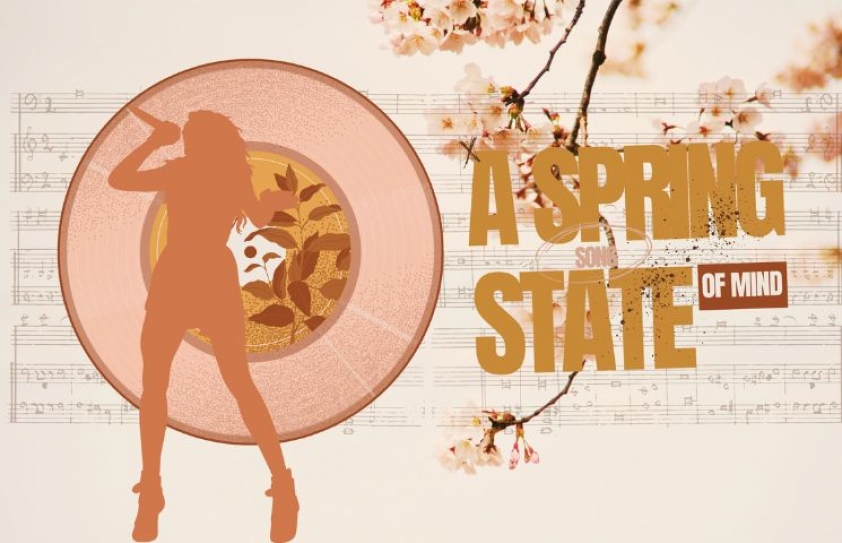
TRENDING: A SPRING SONG STATE OF MIND
by Shantanu Ray Chaudhuri March 14 2025, 12:00 am Estimated Reading Time: 10 mins, 23 secsHindi film songs have celebrated the onset of spring in myriad ways. Shantanu Ray Chaudhuri looks at 5 songs plus one bonus from a Bengali film that evoke the essential spirit of the season…
Spring has long been a muse for poets, artists, and musicians, and Hindi film songs beautifully capture the season’s transient charm. From Sahir Ludhianvi’s evocative verses in Neelay Gagan Ke Taley (Humraaz, 1967) to the playful Aaj Mausam Bada Beimaan Hai (Loafer, 1973), Bollywood’s musical legacy is rich with melodies that celebrate the essence of basant-bahar. These songs weave nature’s splendour with human emotions, creating a timeless appeal. Whether it’s the intoxicating rhythm of Kar Gayi Mast Mujhe (Dillagi, 1979) or the haunting beauty of Faza Bhi Hai Jawan Jawan (Nikaah, 1980), the interplay of lyrics, melody, and voice captures the season’s flirtatious and nostalgic spirit. Adding to this collection is the Bengali gem Boshonto Eshe Gechhe (Chotushkone, 2014), a poetic tribute to love and longing. This curation delves into the cinematic brilliance of these songs, illustrating how they encapsulate spring’s ephemeral beauty and emotional depth.
आओ, आओ फिर, मेरे बसन्त की परी - छवि-विभावरी
सिहरो, स्वर से भर भर, अम्बर की सुन्दरी -छबि-विभावरी – Nirala
Oh, give us pleasure in the flowers to-day;
And give us not to think so far away
As the uncertain harvest; keep us here
All simply in the springing of the year. – Robert Frost
Spring. The very word evokes a verdant landscape of flowers in bloom, blue azure skies, the kind of sunlight that has the power to intoxicate, a breeze redolent of fragrances that arouse a sense of anemoia – nostalgia for a time you have never known. Then there is the strange sensation that Charles Dickens described best when he wrote, ‘It was one of those March days when the sun shines hot and the wind blows cold: when it is summer in the light, and winter in the shade.’
Sadly, in India at least it’s gone almost in the blink of an eye. If Saraswati Puja ushers in the season, with Holi it is well and truly gone and large swathes of the country settle down for the long, blistering summer. Quoting Dickens again, ‘The true nature of the human heart is as whimsical as spring weather.’
However, despite its whimsical and transient nature, or maybe precisely because of that, there’s a timelessness about it. Not surprisingly nothing captures that better than Hindi film songs. Songs on basant-bahar are many in Hindi films. In curating this list, I have tried to avoid the ones that explicitly evoke the words basant-bahar. I explore the nature of spring even if the song does not invoke the season in its lyrics or in the picturisation. After all, spring, like autumn, is a state of the mind and these songs conjure the ineffable, impish spirit of the season best.

Neele gagan ke taley (Humraaz, 1967)
From ‘Thandi hawayen’ (Naujawan), ‘Yeh raat yeh chandni phir kahan’ (Jaal) to ‘Aa bhi jaa’ (Gumrah), very few lyricists have conveyed the beauty of nature in songs as evocatively as Sahir Ludhianvi. As Javed Akhtar mentions in his conversation with Nasreen Munni Kabir, ‘Sahir never allows you to forget the surroundings, the backdrop … he constantly juxtaposes the beauty of nature with his love for a woman.’ That is why his songs transcended the limitation of a genre. Though ‘Neelay gagan ke taley’ does not specifically speak of spring, the imagery in the words and Ravi’s melody summons the sight and sound of the season like few others. What makes the song truly great is the way it weaves human love with elements of nature (‘Shabnam ke moti, phoolon pe bikhre, dono ki aas phaley… Balkhaati belein, masti mein khelein, pedhon se milke galey’) with an overarching philosophy of life (‘Nadiya ka paani, dariya se milke, saagar ki aur chale… Aise hi jag mein, aati hain subhein, aise hi shaam dhale’). The ebb and flow of life, the transience of spring, and the eternal cycle of existence – Sahir’s song is a tribute to it all.
Aaj mausam bada (Loafer, 1973)
I used the word ‘impish’ in the introduction to describe the season. The word I was actually looking for is ‘beimaan’. There is something about the light and feel of a spring day that fits the word to a T. And there is no English equivalent to the word that does justice to what beimaan stands for in the context of the song. So, leave it to Mohammad Rafi to articulate its meaning, the heart’s flirtatious tendencies which finds an echo in the flowers and in the breeze that ruffle the playful clouds:
Kaali-kaali ghataa darr rahi hai
Thandi aahe hawaa bhar rahi hai
Sabko kya-kaa ghumaan ho rahe hai
Har kali ham pe shak kar rahii hai
Phoolon ka dil bhi kuchh badghumaan hai
It’s the season when even the cool breeze sighs with longing and flowers, too, can’t be trusted – their intentions are suspect. Again, there’s no overt mention of spring in the song. However, Laxmikant-Pyarelal’s composition, kicking off with a delightful violin refrain that sets the mood, and Anand Bakshi’s lyrics conjure every element we associate with spring. Then there’s Rafi’s delectable rendition that make trespasses of the heart not just forgivable but desirable too, creating just the perfect montage of the season.
Yeh dil hai aur unki (Prem Parbat, 1973)
A rare instance of a song from a film that never released becoming a cult favourite, counted among the best of Lata Mangeshkar’s oeuvre. Not only did the film remain unreleased, there’s not even a video of the song available anywhere. That leaves the imagination free to call up its own visuals to Jan Nisar Akhtar’s words that evoke nature in all its glory:
Pahadon ko chanchal kiran chumti hai
Hawa har nadi ka badan choomti hai
Or the sense of abandon the season evokes, both desirable and intimidating at the same time:
Dhadakti hai dil kitni azaadiyon se
Bahut milte julte hain in wadiyon se
Lata’s rendition is a lesson in modulating the voice to convey an emotion – just listen to her scale the highs with ‘Lipat-te hain pedhon se baadal ghanere, yeh pal pal ujaale, yeh pal pal andhere’, and the way she whispers ‘Bahot thande thande hain raahon ke saaye’ in the line immediately following. You can almost imagine the cool pathways curling up your feet.
However, what gives the song its sublime quality is Jaidev’s composition. No song in Hindi cinema conveys the many aspects of nature bounty as well as this does only through its music. From the first strains of the santoor and the flute leading to Lata’s voice humming, the melody conjures the images of a soft breeze caressing bubbling brooks, golden sunlight kissing treetops and the chiaroscuro effect that has on the virgin landscape – urging the heart to free itself of all boundaries.
Kar gayi mast mujhe (Dillagi, 1979)
My vote for the best Holi song of Hindi cinema. Not Sholay, not Silsila, definitely not Akshay Kumar exhorting you to ‘Let’s play Holi’. There is an innocence to this song, a throwback to a simpler time that’s hard to disregard. What sets the song apart is also its offbeat three-act structure – from the folksy and boisterous ‘Rang rejwa tu rang aisi chunri hamaar’ with which the song kicks off, before seguing into the mesmerizing Kishore Kumar-Suman Kalyanpuri duet that contains in it the essence of the season. Watch Dharmendra languidly move away from the window, smell a rose and almost tipsily sit down on the sofa as Kishore Kumar’s intoxicating voice takes over to render Rajesh Roshan’s heady composition ‘Kar gayi mast mujhe … main laga jhoomne, mujhe kya honay laga’. The song then goes off into its third act with ‘Jeejaji ko didi ne dhoka diya’ which harks back to the energetic first part, coming full circle in what is Rajesh Roshan offering a masterclass in a fusion of the east and west.
This is the one song in the list that openly articulates the restlessness of what the season entails in young hearts, the colours, the restlessness of the heart, all of which come alive vividly in Yogesh’s words:
Aayi re aayi re aayi rango bhari rut ye aayi
Holi aayi re salone rang aaj thodi thodi
Chhalke megh, holi aayi re holi aayi re
Dilo mein arman kitno ke machlenge holi aayi re
Faza bhi hai jawan jawan (Nikaah, 1980)
My most favourite of songs that evoke nature and/or spring. The picturisation within the confines of a hotel does not help, but close your eyes, give in to Hasan Kamal’s words, and let Ravi’s melody with its violin, santoor and harmonica flourishes transport you to the spring of your imagination.
Have you ever walked out in the afternoon sun on a March-day and wondered how everything that the heart seeks is just out of reach? And yet felt grateful for that? That you have experienced it all and yet cannot quite place the memory in a specific time and space? The words in this song conjure that feeling in spades.
Consider, for example:
Bujhi magar bujhi nahi, na jane kaisi pyaas hai
Karar dil se aaj bhi, na door hai na paas hai
Yeh khel dhoop chhav ka, ye kurbate ye dooriyan
Suna rahan hai ye sama, suni suni si dastan
Or how a moment gives way looking for the next and how each moment, of intimacy and separation, leaves its imprint on the heart:
Har ek pal ko dhoondta, har ek pal chala gaya
Har ek pal firaaq ka, har ek pal visaal ka
Har ek pal guzar gaya, bana ke dil pe ek nishan
Kamal’s lyrics evoke Sahir Ludhianvi’s many odes to nature, some in the 1960s films of B.R. Chopra, such as Gumrah and Hamraaz, in the way he links the desires of the heart to elements of nature. Ravi’s composition adds to those feelings with Salma Agha’s rendition, probably her finest song (‘Dil ke armaan’ notwithstanding), hitting just the right spot to articulate the bittersweet and impossible longings of the runaway heart.
Boshonto eshe gechhe (Chotushkone, 2014)
And as a bonus, this is one lilting song of spring that I love. As with many Anupam Roy songs in films of Srijit Muhkerji, the original version of ‘Boshonto eshe gechhe’ is quite unlike the one used in Chotushkone. According to the composer, the original song is full of political irony. It’s about ‘India shining’ not happening, people selling a false spring. As Anupam mentioned in an interview I did with him a few years ago: ‘At the same time, there was an element of love since my wife, Piya, and I met in spring.’ So, he included some of those moments – like walking down Cornfield Road in Kolkata with her, which he poetically translated to ‘Hethe chhilam bhutta [cornfield] maather pathey’.
Srijit loved the song, though it did not quite fit the situation he had in the film. Determined to include it, he asked Anupam to keep the structure and the hook line intact while reworking it to the demands of the situation. ‘Give me a dated, old-world version of the song,’ is what Srijit told the lyricist and composer. That’s how Anupam wrote the song that Lagnajita Chakraborty sings in the film … it’s almost Rabindrik in its feel – an old-school love song. Lagnajita’s unique voice and the way the song is shot made it special. The words echo the spirit of spring beautifully and its hypnotic refrain ‘Boshonto eshe gechhe’ makes it special:
Bataashe bohiche prem
Nayane lagilo nesha
Kaara je daakilo peechhe
Boshonto eshe gechhe
(Love wafts through the breeze
Intoxicating the vision
Who is it calling out to me
Spring is here)

46.jpg)
43.jpg)



-173X130.jpg)
-173X130.jpg)
-173X130.jpg)
-173X130.jpg)
-173X130.jpg)
-173X130.jpg)
-173X130.jpg)
-173X130.jpg)